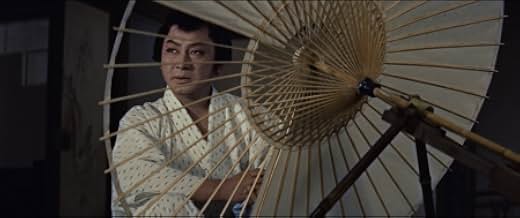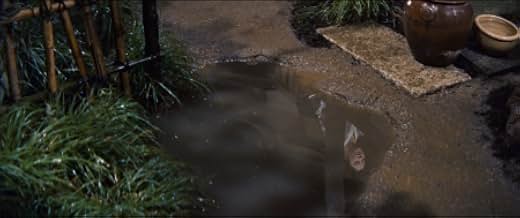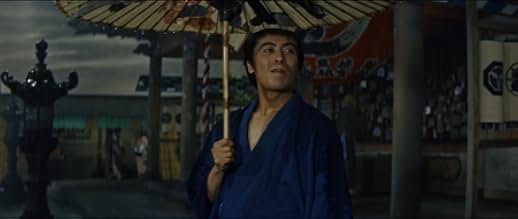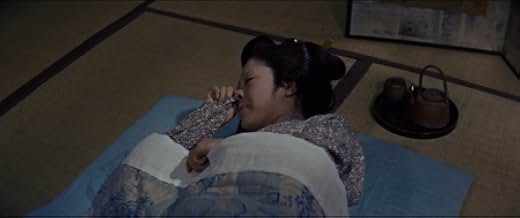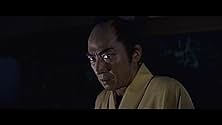NOTE IMDb
7,0/10
2,1 k
MA NOTE
Ajouter une intrigue dans votre langueThe ghost of a samurai's wife takes revenge on her husband.The ghost of a samurai's wife takes revenge on her husband.The ghost of a samurai's wife takes revenge on her husband.
- Réalisation
- Scénario
- Casting principal
Katsuko Wakasugi
- Iwa
- (as Kazuko Wakasugi)
Avis à la une
Funny how things change. In 1949 Shintoho was producing prestige films like Akira Kurosawa's STRAY DOG. Ten years later they were producing scores of everything from lurid melodramas to nationalist war movies to cheap gangster flicks to kaidan period horror movies like this. Two years later, in 1961, they declared bankruptcy and closed shop, the first semi-big studio in postwar Japan to do so. Nobuo Nakagawa, along with Teruo Ishii who graduated from the film noir of the Chitai series into full blown sleaze and torture 10 years later, was one of those prolific studio filmmakers responsible for many of their kaidan pictures. His biggest call to fame is JIGOKU from the following year but this is an ample showcase of both the good and the bad of Shintoho film-making.
Based on the classic story by Nanboku Tsuruya about a conniving lowly samurai who is haunted by the ghost of the wife he murdered, a lot of the drama is hackneyed, the characters simple caricatures of good and evil, innocent and scheming, the dialogues delivered on-the-nose. Iemon, the murderous samurai, is played and depicted as the worst villain possible. No grey areas here, nothing morally ambiguous, the movie is melodrama played to the back of the house. And yet, the first appearance of the ghost sent chills down my spine. Ringu and Ju On didn't invent the pale-faced ghost that creeps along the edge of the frame. It was there 50 years ago and in Kabuki theater before that.
With the eye of a stylist, Nakagawa orchestrates a vision of hell on earth, ghosts rising from the ground or peering down from the ceiling, and it's all very stagey and theatrical probably to appeal to an audience already familiar with the story from Kabuki theater and as much creepy/atmospheric as it is graphic, certainly more graphic than American horror would dare to be for the next 10 years (we have blood gushing from wounds, facial deformities, and even an amputated limb), and while the whole is never as good as the parts, those parts should appeal to the horror fan who likes his lighting bright red and torquoise and his ghosts slow-moving and disfigured.
Based on the classic story by Nanboku Tsuruya about a conniving lowly samurai who is haunted by the ghost of the wife he murdered, a lot of the drama is hackneyed, the characters simple caricatures of good and evil, innocent and scheming, the dialogues delivered on-the-nose. Iemon, the murderous samurai, is played and depicted as the worst villain possible. No grey areas here, nothing morally ambiguous, the movie is melodrama played to the back of the house. And yet, the first appearance of the ghost sent chills down my spine. Ringu and Ju On didn't invent the pale-faced ghost that creeps along the edge of the frame. It was there 50 years ago and in Kabuki theater before that.
With the eye of a stylist, Nakagawa orchestrates a vision of hell on earth, ghosts rising from the ground or peering down from the ceiling, and it's all very stagey and theatrical probably to appeal to an audience already familiar with the story from Kabuki theater and as much creepy/atmospheric as it is graphic, certainly more graphic than American horror would dare to be for the next 10 years (we have blood gushing from wounds, facial deformities, and even an amputated limb), and while the whole is never as good as the parts, those parts should appeal to the horror fan who likes his lighting bright red and torquoise and his ghosts slow-moving and disfigured.
This classic japanese tale has been filmed many times. It's the story of a samurai's betrayal of his wife and the ultimate vengeance her spirit seeks. The spectre of her ghost haunting the mind of her husband is almost like seeing a japanese "The Shining".
This film essentially begins with a young samurai by the name of "Iemon Tamiya" (Shigeru Amachi) asking a more high-level samurai named "Samon Yotsuya" (Shinjiro Asano) to marry his daughter "Iwa Yotsuya). In response, Samon angrily refuses because he considers Iemon to be much too hedonistic and of low-moral character. Not surprisingly, this infuriates Iemon and, as if to prove Samon's point-he furiously draws his sword and kills the older man on the spot. Having witnessed the murder and wanting to capitalize on it, a cunning peasant named "Naosuke" (Shuntaro Emi) appears from the shadows and advises Iemon on exactly what to do next. Needless to say, Iemon listens quite intensely and in relatively little time he does, in fact, marry Iwa. Likewise, Naosuke also gets closer to realizing his ambition of marrying Iwa's sister "Sode" (Noriko Kitazawa) who was always out of reach for him due to his low status in life. However, what neither Iemon or Naosuke realize is that, eventually, their evil deeds will catch up to them--and when they do--they come in a most bizarre manner. Now, rather than reveal any more, I will just say that this was a good horror film which took a bit of time laying down the foundation of the story before really increasing in intensity later on. Admittedly, the costumes and makeup used pale in comparison to the CGI and special effects found in more modern films of today. No question about it. But even so, I thought that the overall movie was still quite entertaining, and I have rated it accordingly.
The classic tale of 'The Ghost of Yotsuya' is entertaining enough, and zips along in its 76 minute run time, but it didn't deliver any knockout blows. The story is fairly black and white, with a ronin and his sidekick committing murder to get the women they want, but the depth of the blackness in their hearts is surprising, and makes it effective. Personally, I didn't find their supernatural comeuppance all that frightening, and felt that director Nobuo Nakagawa relied too much on the shock value of visuals, instead of creating real tension. The visuals are decent, but they're also dated, and we rarely fail to see what's coming. The performances were also generally over-done, though I understand my perspective is from another culture. Anyway, fans of the genre will probably enjoy this one.
And who can fault Iwa's fury? Her husband Iemon murders her father to marry her, deceives her into parting from her sister, fathers her child, pays another man to seduce her, then administers a disfiguring poison so he can marry another woman. Yet Iemon is not wholly wicked - he suffers pangs of conscience, and most of his crimes are the result of his servant's goading. Whilst our sympathy goes to Iwa, our empathy extends to Iemon. The film is endowed with the dimensions of a classical tragedy, as the director undoubtedly intended. In fact, the picture's opening scenes are unabashedly stage-bound, before it shifts subtly into an engrossing cinematic experience. Although the story has been adapted to film many times in Japan, this is generally considered the definitive version.
Besides its dramatic power, this version of Ghost Story of Yotsuya is visually sumptuous and thrillingly scored, the scope compositions are masterly, and the female phantom's appearance is truly nightmarish.
This is easily the most accomplished, frightening and satisfying of Nakagawa's period ghost stories.
Besides its dramatic power, this version of Ghost Story of Yotsuya is visually sumptuous and thrillingly scored, the scope compositions are masterly, and the female phantom's appearance is truly nightmarish.
This is easily the most accomplished, frightening and satisfying of Nakagawa's period ghost stories.
Le saviez-vous
- ConnexionsFeatured in Building the Inferno: Nobuo Nakagawa and the Making of 'Jigoku' (2006)
Meilleurs choix
Connectez-vous pour évaluer et suivre la liste de favoris afin de recevoir des recommandations personnalisées
- How long is The Ghost of Yotsuya?Alimenté par Alexa
Détails
- Durée
- 1h 16min(76 min)
- Rapport de forme
- 2.35 : 1
Contribuer à cette page
Suggérer une modification ou ajouter du contenu manquant

